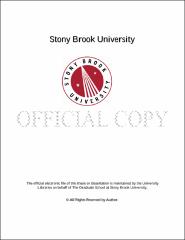| dc.identifier.uri | http://hdl.handle.net/11401/76448 | |
| dc.description.sponsorship | This work is sponsored by the Stony Brook University Graduate School in compliance with the requirements for completion of degree. | en_US |
| dc.format | Monograph | |
| dc.format.medium | Electronic Resource | en_US |
| dc.language.iso | en_US | |
| dc.publisher | The Graduate School, Stony Brook University: Stony Brook, NY. | |
| dc.type | Thesis | |
| dcterms.abstract | Transparent conducting films, or TCFs, are 2D electrical conductors with the ability to transmit light. Because of this, they are used in many popular electronics including smart phones, tablets, solar panels, and televisions. The most common material used as a TCF is indium tin oxide, or ITO. Although ITO has great electrical and optical characteristics, it is expensive, brittle, and difficult to pattern. These limitations have led researchers toward other materials for the next generation of displays and touch panels. The most promising material for next generation TCFs is carbon nanotubes, or CNTs. CNTs are cylindrical tubes of carbon no more than a few atoms thick. They have different electrical and optical properties depending on their atomic structure, and are extremely strong. As an electrode, they conduct electricity through an array of randomly dispersed tubes. The array is highly transparent because of gaps between the tubes, and size and optical properties of the CNTs. Many research groups have tried making CNT TCFs with opto-electric properties similar to ITO but have difficultly achieving high conductivity. This is partly attributed to impurities from fabrication and a mix of different tube types, but is mainly caused by low junction conductivity. In functionalized nanotubes, junction conductivity is impaired by covalently bonded molecules added to the sidewalls of the tubes. The addition of this molecule, known as functionalization, is designed to facilitate CNT dispersion in a solvent by adding properties of the molecule to the CNTs. While necessary for a good solution, functionalization decreases the conductivity in the CNT array by creating defects in the tube's structures and preventing direct inter-carbon bonding. This research investigates removing the functional coating (after tube deposition) by laser processing. Laser light is able to preferentially heat the CNTs because of their optical and electrical properties. Through local conduction, the relatively weak functional molecules are thermally decomposed. This restores the pristine CNT structure and allows carbon to carbon bonds to form; thereby significantly improving the junction and sheet conductivity. Laser processing is performed without damaging the TCF substrate (usually glass or PET) because laser light is not absorbed by the substrate and conduction from the CNTs is limited. In addition to removing the functional coating, laser light improves the electrical conductivity by purifying the CNT array. The purity is improved through the ablation of defective tubes and amorphous carbon in the CNT film.[1] Using higher laser power, it is possible to locally remove the CNTs. Selective laser removal of the CNTs is a dry process that can be used to pattern the electrode. This is a much simpler and less expensive patterning technique than wet acid etching used for ITO. In summary, laser processing of CNT TCFs is shown to improve the electrical conductivity by defunctionalizing the CNTs. In addition, laser exposure increases purity by removing defects and can be used to pattern the electrode. These advances make CNTs more competitive as an alternative for ITO which has both cost and performance limitations. | |
| dcterms.available | 2017-09-20T16:50:17Z | |
| dcterms.contributor | Longton, Jon | en_US |
| dcterms.contributor | Hwang, David | en_US |
| dcterms.contributor | Alkhader, Maen. | en_US |
| dcterms.creator | Mann, Andrew | |
| dcterms.dateAccepted | 2017-09-20T16:50:17Z | |
| dcterms.dateSubmitted | 2017-09-20T16:50:17Z | |
| dcterms.description | Department of Mechanical Engineering. | en_US |
| dcterms.extent | 56 pg. | en_US |
| dcterms.format | Monograph | |
| dcterms.format | Application/PDF | en_US |
| dcterms.identifier | http://hdl.handle.net/11401/76448 | |
| dcterms.issued | 2013-12-01 | |
| dcterms.language | en_US | |
| dcterms.provenance | Made available in DSpace on 2017-09-20T16:50:17Z (GMT). No. of bitstreams: 1
Mann_grad.sunysb_0771M_11471.pdf: 4245047 bytes, checksum: 4214c56970073726bb1af67db531a7e4 (MD5)
Previous issue date: 1 | en |
| dcterms.publisher | The Graduate School, Stony Brook University: Stony Brook, NY. | |
| dcterms.subject | Absorption, Carbon Nanotube, Electrode, Heating, Laser, Transparent | |
| dcterms.subject | Mechanical engineering | |
| dcterms.title | Laser Processing of Carbon Nanotube Transparent Conducting Films | |
| dcterms.type | Thesis | |

